(Press-News.org)
Image
In a solar system called TRAPPIST-1, 40 light years from the sun, seven Earth-sized planets revolve around a cold star.
Astronomers obtained new data from the James Webb Space Telescope (JWST) on TRAPPIST-1 b, the planet in the TRAPPIST-1 solar system closest to its star. These new observations offer insights into how its star can affect observations of exoplanets in the habitable zone of cool stars. In the habitable zone, liquid water can still exist on the orbiting planet's surface.
The team, which included University of Michigan astronomer and NASA Sagan Fellow Ryan MacDonald, published its study in the journal The Astrophysical Journal Letters.
"Our observations did not see signs of an atmosphere around TRAPPIST-1 b. This tells us the planet could be a bare rock, have clouds high in the atmosphere or have a very heavy molecule like carbon dioxide that makes the atmosphere too small to detect," MacDonald said. "But what we do see is that the star is absolutely the biggest effect dominating our observations, and this will do the exact same thing to other planets in the system."
The majority of the team's investigation was focused on how much they could learn about the impact of the star on observations of the TRAPPIST-1 system planets.
"If we don't figure out how to deal with the star now, it's going to make it much, much harder when we look at the planets in the habitable zone—TRAPPIST-1 d, e and f—to see any atmospheric signals," MacDonald said.
A promising exoplanetary system
TRAPPIST-1, a star much smaller and cooler than our sun located approximately 40 light-years away from Earth, has captured the attention of scientists and space enthusiasts alike since the discovery of its seven Earth-sized exoplanets in 2017. These worlds, tightly packed around their star with three of them within its habitable zone, have fueled hopes of finding potentially habitable environments beyond our solar system.
The study, led by Olivia Lim of the Trottier Institute for Research on Exoplanets at the University of Montreal, used a technique called transmission spectroscopy to gain important insights into the properties of TRAPPIST-1 b. By analyzing the central star's light after it has passed through the exoplanet's atmosphere during a transit, astronomers can see the unique fingerprint left behind by the molecules and atoms found within that atmosphere.
"These observations were made with the NIRISS instrument on JWST, built by an international collaboration led by René Doyon at the University of Montreal, under the auspices of the Canadian Space Agency over a period of nearly 20 years," said Michael Meyer, U-M professor of astronomy. "It was an honor to be part of this collaboration and tremendously exciting to see results like this characterizing diverse worlds around nearby stars coming from this unique capability of NIRISS."
Know thy star, know thy planet
The key finding of the study was the significant impact of stellar activity and contamination when trying to determine the nature of an exoplanet. Stellar contamination refers to the influence of the star's own features, such as dark regions called spots and bright regions called faculae, on the measurements of the exoplanet's atmosphere.
The team found compelling evidence that stellar contamination plays a crucial role in shaping the transmission spectra of TRAPPIST-1 b and, likely, the other planets in the system. The central star's activity can create "ghost signals" that may fool the observer into thinking they have detected a particular molecule in the exoplanet's atmosphere.
This result underscores the importance of considering stellar contamination when planning future observations of all exoplanetary systems. This is especially true for systems like TRAPPIST-1, since it is centered around a red dwarf star that can be particularly active with starspots and frequent flare events.
"In addition to the contamination from stellar spots and faculae, we saw a stellar flare, an unpredictable event during which the star looks brighter for several minutes to hours," Lim said. "This flare affected our measurement of the amount of light blocked by the planet. Such signatures of stellar activity are difficult to model but we need to account for them to ensure that we interpret the data correctly."
MacDonald played a key role in modeling the impact of the star and searching for an atmosphere in the team's observations, running a series of millions of models to explore the full range of properties of cool starspots, hot star active regions and planetary atmospheres that could explain the JWST observations the astronomers were seeing.
No significant atmosphere on TRAPPIST-1 b
While all seven of the TRAPPIST-1 planets have been tantalizing candidates in the search for Earth-sized exoplanets with an atmosphere, TRAPPIST-1 b's proximity to its star means it finds itself in harsher conditions than its siblings. It receives four times more radiation than the Earth does from the sun and has a surface temperature between 120 and 220 degrees Celsius.
However, if TRAPPIST-1 b were to have an atmosphere, it would be the easiest to detect and describe of all the targets in the system. Since TRAPPIST-1 b is the closest planet to its star and thus the hottest planet in the system, its transit creates a stronger signal. All these factors make TRAPPIST-1 b a crucial, yet challenging target of observation.
To account for the impact of stellar contamination, the team conducted two independent atmospheric retrievals,a technique to determine the kind of atmosphere present on TRAPPIST-1 b, based on observations. In the first approach, stellar contamination was removed from the data before they were analyzed. In the second approach, conducted by MacDonald, stellar contamination and the planetary atmosphere were modeled and fit simultaneously.
In both cases, the results indicated that TRAPPIST-1 b's spectra could be well matched by the modeled stellar contamination alone. This suggests no evidence of a significant atmosphere on the planet. Such a result remains very valuable, as it tells astronomers which types of atmospheres are incompatible with the observed data.
Based on their collected JWST observations, Lim and her team explored a range of atmospheric models for TRAPPIST-1 b, examining various possible compositions and scenarios. They found that cloud-free, hydrogen-rich atmospheres were ruled out with high confidence. This means that there appears to be no clear, extended atmosphere around TRAPPIST-1 b.
However, the data could not confidently exclude thinner atmospheres, such as those composed of pure water, carbon dioxide or methane, nor an atmosphere similar to that of Titan, a moon of Saturn and the only moon in the solar system with a significant atmosphere. These results, the first spectrum of a TRAPPIST-1 planet, are generally consistent with previousJWST observations of TRAPPIST-1 b's dayside seen in a single color with the MIRI instrument.
As astronomers continue to explore other rocky planets in the vastness of space, these findings will inform future observing programs on the JWST and other telescopes, contributing to a broader understanding of exoplanetary atmospheres and their potential habitability.
Study: Atmospheric Reconnaissance of TRAPPIST-1 b with JWST/NIRISS: Evidence for Strong Stellar Contamination in the Transmission Spectra
END
JWST's first spectrum of a TRAPPIST-1 planet
U-M astronomer played key role in study of exoplanet that reveals new insights into its atmosphere and star
2023-09-27
ELSE PRESS RELEASES FROM THIS DATE:
Wild Asian elephants display unique puzzle solving skills
2023-09-27
New York, September 27, 2023 – Individual innovation is considered one sign of intelligence within species, and elephants are among the animals that researchers have long taken an interest in because of their sophisticated approach to problem solving. A newly published study in the journal Animal Behaviour details findings from a six-month-long study documenting the abilities of individual wild Asian elephants to access food by solving puzzles that unlocked storage boxes.
“This is the first research study to show that individual wild elephants have different willingness and abilities to problem solve in ...
Mainstay malaria drug may be beginning to fail in the Horn of Africa
2023-09-27
In eastern Africa, malaria parasites have developed resistance to artemisinins, the backbone of current treatment regimens, a development that could dramatically worsen malaria’s impact if partner drugs fail in the future.
The finding from studies in Eritrea was reported Sept. 28 in the New England Journal of Medicine by a team of researchers led by Didier Ménard, PhD, of the Université de Strasbourg/Institut Pasteur in France and including Columbia University microbiologist David Fidock, PhD, the C.S. Hamish Young Professor of Microbiology & Immunology and professor of medical sciences in the Vagelos College of Physicians and Surgeons.
Treatment ...
Separating molecules requires lots of energy. This new, heat-resistant membrane could change that
2023-09-27
BUFFALO, N.Y. – Industry has long relied upon energy-intensive processes, such as distillation and crystallization, to separate molecules that ultimately serve as ingredients in medicine, chemicals and other products.
In recent decades, there has been a push to supplant these processes with membranes, which are potentially a lower-cost and eco-friendly alternative. Unfortunately, most membranes are made from polymers that degrade during use, making them impractical.
To solve this problem, a University at Buffalo-led research team ...
MSU works to make drinking water safer by fighting contaminants
2023-09-27
EAST LANSING, Mich. – Providing safe drinking water was a great public health achievement in the 20th century, yet problems persist. According to the Centers for Disease Control and Prevention, about 7.15 million waterborne illnesses occur in the United States annually resulting in 601,000 emergency room visits, 6,630 deaths and $3.33 billion in direct health care costs. Michigan State University, a world leader in water research, is working to make our drinking water safer.
MSU has been awarded a $2.1 million grant from the U.S. Environmental Protection ...
Want to make better decisions? Ask for less information, not more
2023-09-27
When people have to make a tough decision, their first instinct is usually to gather as much information as possible. Just one problem: according to research published this week in Cognitive Research: Principles and Implications, most people’s decision-making actually gets worse, not better, when you give them additional facts and details.
“It’s counterintuitive, because we all like to think we use information wisely to make smart decisions,” said Farber Chair Associate Professor ...
HMS researcher to lead $104 million federal project tackling antibiotic resistance
2023-09-27
At a glance:
Johan Paulsson, HMS professor of systems biology, will lead project studying bacterial behavior and antibiotic resistance.
Efforts will focus on developing technology to improve diagnosis, speed discovery of new antibiotics, and illuminate basic mechanisms of bacterial behavior.
Harvard Medical School researcher Johan Paulsson will lead a multi-institutional $104 million effort to study bacteria and antibiotic resistance, the U.S. Department of Health and Human Services announced today.
The work is funded by the newly established Advanced Research Projects Agency for Health (ARPA-H) in an ...
Study provides new look at why rare cancer often evades treatments
2023-09-27
BOSTON - Researchers at Boston Medical Center and Dana-Farber Cancer Institute conducted one of the first-ever analyses of neuroendocrine tumors (NETs) at single cell resolution, unlocking new insights into this rare and often hard-to-treat cancer. The findings represent a tremendous leap forward in understanding why these tumors are largely resistant to immunotherapy and provide key insights that could lead to future treatments.
“This study was a tour-de-force that catalyzed the efforts and innovations of researchers across Boston – including Boston Medical Center and Dana-Farber Cancer Institute - and has resulted in a better understanding ...
Opportunities to improve lung cancer care for older patients
2023-09-27
“With the majority of lung cancer patients being older than 65, it is imperative that actions are taken to encourage and facilitate clinical trials among older patients.”
BUFFALO, NY- September 27, 2023 – A new editorial paper was published in Aging (listed by MEDLINE/PubMed as "Aging (Albany NY)" and "Aging-US" by Web of Science) Volume 15, Issue 17, entitled, “Promising trends in lung cancer care, but are we overlooking the majority?”
In their new editorial, ...
Reassessing COVID-19 precautions in 2023
2023-09-27
“The balance between appropriate precautions and the harm of social isolation always requires a thorough appraisal.”
BUFFALO, NY- September 27, 2023 – A new editorial paper was published in Oncotarget's Volume 14 on September 22, 2023, entitled, “Reassessing the risks and benefits of COVID-19 precautions in 2023.”
The COVID-19 pandemic has killed over one million Americans with many dying during the Omicron wave. By now most Americans have either had COVID-19 and/or been vaccinated against it. Despite the availability of updated immunizations, only 16.7% of Americans are now up-to-date on bivalent ...
Is a longer reproductive lifespan good for your brain?
2023-09-27
EMBARGOED FOR RELEASE UNTIL 4 P.M. ET, WEDNESDAY, SEPTEMBER 27, 2023
MINNEAPOLIS – People with a higher cumulative estrogen exposure throughout their life may have a lower risk of cerebral small vessel disease, according to a new study published in the September 27, 2023, online issue of Neurology®, the medical journal of the American Academy of Neurology.
Cerebral small vessel disease, a form of cerebrovascular disease, results from damage to small blood vessels in the brain. It raises the risk of cognitive impairment and dementia.
“Previous research has shown that rates of cerebrovascular disease increase after menopause, which is often attributed ...
LAST 30 PRESS RELEASES:
Heart-brain connection: international study reveals the role of the vagus nerve in keeping the heart young
Researchers identify Rb1 as a predictive biomarker for a new therapeutic strategy in some breast cancers
Survey reveals ethical gaps slowing AI adoption in pediatric surgery
Stimulant ADHD medications work differently than thought
AI overestimates how smart people are, according to HSE economists
HSE researchers create genome-wide map of quadruplexes
Scientists boost cell "powerhouses" to burn more calories
Automatic label checking: The missing step in making reliable medical AI
Low daily alcohol intake linked to 50% heightened mouth cancer risk in India
American Meteorological Society announces Rick Spinrad as 2026 President-Elect
Biomass-based carbon capture spotlighted in newly released global climate webinar recording
Illuminating invisible nano pollutants: advanced bioimaging tracks the full journey of emerging nanoscale contaminants in living systems
How does age affect recovery from spinal cord injury?
Novel AI tool offers prognosis for patients with head and neck cancer
Fathers’ microplastic exposure tied to their children’s metabolic problems
Research validates laboratory model for studying high-grade serous ovarian cancer
SIR 2026 delivers transformative breakthroughs in minimally invasive medicine to improve patient care
Stem Cell Reports most downloaded papers of 2025 highlight the breadth and impact of stem cell research
Oxford-led study estimates NHS spends around 3% of its primary and secondary care budget on the health impacts of heat and cold in England
A researcher’s long quest leads to a smart composite breakthrough
Urban wild bees act as “microbial sensors” of city health.
New study finds where you live affects recovery after a hip fracture
Forecasting the impact of fully automated vehicle adoption on US road traffic injuries
Alcohol-related hospitalizations from 2016 to 2022
Semaglutide and hospitalizations in patients with obesity and established cardiovascular disease
Researchers ‘listen in’ to embryo-mother interactions during implantation using a culture system replicating the womb lining
How changing your diet could help save the world
How to make AI truly scalable and reliable for real-time traffic assignment?
Beyond fragmented markets: A new framework for efficient and stable ride-pooling
Can shape priors make road perception more reliable for autonomous driving?
[Press-News.org] JWST's first spectrum of a TRAPPIST-1 planetU-M astronomer played key role in study of exoplanet that reveals new insights into its atmosphere and star



